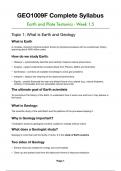Class notes
GEO1009F Full Syllabus Lecture Notes Summary
- Course
- Institution
Full Course notes for GEO1009. Includes a summarized version of all notes and PowerPoints on all three sections in the first semester course (Geology, Archaeology, EGS) . Relevant diagrams included to further enforce understanding. These notes will help you achieve great results in Tests and the Ex...
[Show more]



